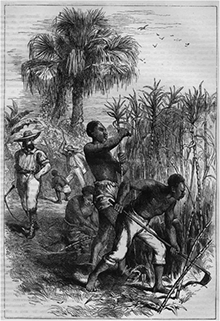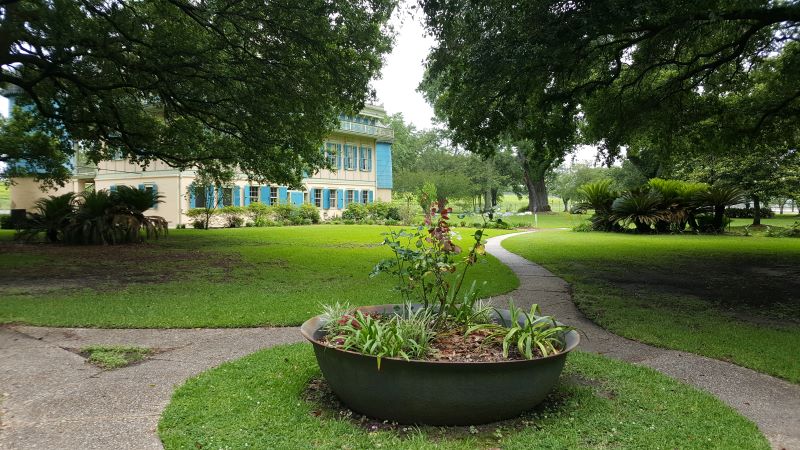Sugar Kettle Art
In my many travels to New Orleans, I noticed a peculiar trend in the gardening and landscaping of historic homes. Giant iron kettles or cauldrons were used as fountains or humungous flowerpots. I didn’t think anything of them at first, besides a creative repurposing of something huge and old. It wasn’t until I visited Whitney Plantation that I saw them again, but this time, they weren’t put on the lawn for an aesthetic function.

Louisiana’s first cash crops consisted of indigo and rice, two products that proved beneficial to the economy of 18th century France. Africans with the knowledge to cultivate these crops were captured and transported to Louisiana as forced labor to assist in the growing of these crops.[1] By 1720, Louisiana began to export rice to the French Antilles, and by the 1750s, indigo became one of the major cash crops of the area, reaching a value of 1,350,000 livres by the year 1760.[2] Using the Mississippi River and the port of New Orleans, these goods found an easy means of exportation.
Indigo production would decline in the latter quarter of the eighteenth century for a variety of reasons, the most impactful being the addition of indigo trade with India, which caused the price of indigo elsewhere to drop significantly.[3] The decline in indigo forced plantations in Louisiana to diversify and adjust, leading to the new production of cotton and sugarcane. These labor-intensive crops required greater manpower to process, prompting greater demand for enslaved labor. This swing in agricultural focus would lead New Orleans to depend heavily on the institute of slavery, shaping its fate in the nineteenth century.

The production of sugar was dangerous and laborious for the enslaved. The system for granulating raw sugar was developed by Etienne de Boré, a former indigo planter looking to break into the sugar industry. The harvested cane was crushed using an animal-powered three-roller mill. The extracted cane juice was heated, clarified, and evaporated in a set of large sugar kettles of decreasing size which were enclosed in brickwork over a furnace. After syrup coagulated from the evaporation of the juice, manufacturers determined when sugar crystals had formed. This was called a “Strike” and was the point at which the concentrated syrup was turned out into shallow wooden tanks and left to cool.[4]
 An enslaved worker at a sugar plantation could endure a variety of debilitating or life-threatening injuries each year between October and December – harvesting and grinding season. The leaves of the sugar plants were thin, but strong and sliced into the hands and arms of those cutting the cane. This would be a little worse than a papercut, which would then sting when sweat poured over the wound. Improperly feeding the cane into the grinding mill could result in a mutilated limb which would need amputation. The enslaved could sustain third-degree burns as they ladled the boiling-hot liquid from one kettle to the next. All of these injuries had the risk of becoming infected. Add all other aspects of slavery on top of these conditions and one might gain a glimpse into the nature of sugar production in the Deep South.
An enslaved worker at a sugar plantation could endure a variety of debilitating or life-threatening injuries each year between October and December – harvesting and grinding season. The leaves of the sugar plants were thin, but strong and sliced into the hands and arms of those cutting the cane. This would be a little worse than a papercut, which would then sting when sweat poured over the wound. Improperly feeding the cane into the grinding mill could result in a mutilated limb which would need amputation. The enslaved could sustain third-degree burns as they ladled the boiling-hot liquid from one kettle to the next. All of these injuries had the risk of becoming infected. Add all other aspects of slavery on top of these conditions and one might gain a glimpse into the nature of sugar production in the Deep South.
In 1843, Norbert Rillieuz patented a new sugar processing method that incorporated multiple pans stacked inside a vacuum chamber that evaporated the sugar juices in stages. Sugar would crystalize in wooden vats and then be packed in 1,000-pound hogsheads, or “boucauts” as they were called in French communities, before they were shipped to market. This improved the refining process, saving time, money, and lives.[5] The sugar kettles became obsolete and planters no longer had a use for them. They would be repurposed into laundry kettles for washing clothes or large cookpots used by the enslaved. After emancipation and as more newly freed blacks left plantations – albeit slower in some areas than in others – sugar kettles served as a reminder of the life they left behind.

Fast forward to modern times, these sugar kettles have been revamped again, but as lawn or garden ornaments. They may also be found in museums or collecting rainwater around abandoned plantation mansions. Whitney Plantation has the largest collection of sugar kettles in the state of Louisiana, and they display them throughout their grounds, adding historical context to an already powerful visitor experience. (side note: Whitney Plantation is a must-visit if you’re in the New Orleans area)

Other plantations, like Oak Alley and Laura Plantation, display their sugar kettles differently, but provide an abundance of education about the formerly enslaved communities on their property. The bulk of the tour at Laura Plantation is dedicated to telling the full story of antebellum and creole culture, and Oak Alley has progressed leaps and bounds in the way of incorporating these lessons into their own tours. While they have two sugar kettles “dressed up” for guests, they have a third that is interpreted as a laundry kettle near their recreated quarters. San Francisco Plantation – no longer open for tours – also showed off two sugar kettle fountains, but had an entire display with informational signs about the risks of processing sugar on the plantation.

Therefore, these locations give a faithful and balanced picture of the people who used to live, work, and died at their plantation. The historians at neither plantation were available for comment on their intention in using sugar kettles as fountains and planters, due to their busy efforts in rebuilding after Hurricane Ida.
The sugar kettles that have been refashioned into horticultural artwork can be viewed as a symbolic transformation. They took something that once facilitated great harm to the enslaved and made it into something beautiful and pleasing to the eye. A cursory search for “sugar kettle” comes up with a multitude of ways to take these giant iron vats and convert them into art. This is not a new or revolutionary craze, as many things old and vintage – some with troubled pasts and some not – have been reused or refitted for modern consumers.
My question to readers is: what do you think? Should sugar kettles not be taken out of its historical context or should we, as stewards of artifacts and historical memory, try to make something beautiful from what once reinforced the institute of slavery?
Endnotes
[1] Ibrahim Seck, Bouki Fait Gombo: A History of the Slave Community of Habitation Haydel (Whitney Plantation) Louisiana, 1750-1860, University of New Orleans Press, 2014 pp. 64-67
[2] Gwendolyn Midlo Hall, Africans in Colonial Louisiana: The Development of Afro-Creole Culture in the Eighteenth-Century, Baton Rouge, LSU Press, 1992, p. 122; N. M. Miller Surrey, The Commerce of Louisiana during the French Regime, 1699–1763. New York Chichester, West Sussex: Columbia University Press, 1916, 214-215;
[3] Collot 1826, A journey in North America, Volume 2, Paris, Arthus Bertrand, pp. 166-167
[4] David Feldman, “Sugar Kettles of New Orleans” February 16, 2017, Luckybeantours.com. Accessed November 7, 2021. https://www.luckybeantours.com/the-sugar-kettles-of-new-orleans/.
[5] Seck, pp. 79-80
Fantastic post. So original! Bravo!
Thanks Sherrita for another interesting and informative post. Keep up the good work. We are proud of you.
F. Norman Vickers
Pensacola Civil War Roundtable
What a neat post!
I personally have no issue with repurposing the kettles for use as gardens. Part of that is because I generally believe that the more gardens (or all types) we have, the better. Similarly, the more art we have, the better. Repurposing the kettles is also in the tradition of a long line of re-using such things. As a crazy example, I think of that old fad of taking old tires, turning them inside out, painting them, putting them in a front yard, and putting flowers in them.
I don’t recall ever seeing a sugar kettle in Hawaii. That may partly be due to sugar being a difficult venture until the civil war created a tremendous increase in demand, attracting capital to the Islands which could support more advanced milling operations. Hawaii depended on imported contract labor rather than a slave system. Today the old mills are viewed as cultural artifacts with affection for the old “plantation days lifestyle”.
Wonderful post! I am for repurposing the kettles. There are so many relics throughout the world that have been “absorbed” (repurposed) into the current local culture so as to not loose it. Thanks Sheritta!
My parents have an old sugar kettle “pond” in their yard. Very common in Louisiana to have. Maybe it’ll freeze over once this winter.